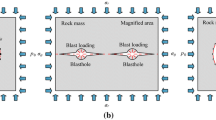Abstract
One of the popular methods of underground and surface excavations is the use of blasting. Throughout this method of excavation, the loading resulted from blasting can be affected by different geo-mechanical and structural parameters of rock mass. Several factors affect turbulence in underground structures some of which are explosion, vibration, and stress impulses caused by the neighbouring blasting products. In investigating the blasting mechanism one should address the processes which expand with time and cause seismic events. To protect the adjoining structures against any probable deconstruction or damage, it is very important to model the blasting process prior to any actual operation. Efforts have been taken in the present study to demonstrate the potentiality of numerical methods in predicting the specified parameters in order to prevent any probable destruction. For this purpose the blasting process was modeled, according to its natural implementation, in one of the tunnels of Siahbishe dam by the 3DEC and AUTODYN 3D codes. 3DEC was used for modeling the blasting environment as well as the blast holes and AUTODYN 3D for modeling the explosion process in the blast hole. In this process the output of AUTODYN 3D, which is a result of modeling the blast hole and is in the form of stress waves, is entered into 3DEC. For analyzing the amount of destruction made by the blasting operation, the key parameter of Peak Particle Velocity was used. In the end, the numerical modeling results have been compared with the data recorded by the seismographs planted through the tunnel. As the results indicated 3DEC and AUTODYN 3D proved appropriate for analyzing such an issue. Therefore, by means of these two softwares one can analyze explosion processes prior to their implementation and make close estimation of the damage resulting from these processes.


















Similar content being viewed by others
References
W. Hustrulid, Blasting Principles for Open Pit Mining, vol. 1 (A.A. Balkema, Amsterdam, 1999)
D.E. Grady, M.E. Kipp, Continuum modeling of explosive fracture in oil shale. Int. J. Rock Min. Sci. Geomech. Abstr. 17, 147–157 (1980)
D.S. Preece, B.J. Thorne, A study of detonation timing and fragmentation using 3-D finite element techniques and a damage constitutive model. Fragblast 5, 147–156 (1996)
F.V. Donzé, J. Bouchez, S.A. Magnier, Modeling fractures in rock blasting. Int. J. Rock Mech. Min. Sci. 34(8), 1153–1163 (1997)
G.W. Ma, H. Hao, Y.X. Zhou, Modeling of wave propagation induced by underground explosion. Comput. Geotech. 22(3–4), 283–303 (1998)
S.G. Chen, J. Zhao, A study of UEDC modeling for blasting wave propagation in joint rock mass. Int. J. Rock Mech. Min. Sci. 35, 93–99 (1998)
X.F. Deng, J.B. Zhu, S.G. Chen, Z.Y. Zhao, Y.X. Zhou, J. Zhao, Numerical study on tunnel damage subject to blast-induced shock wave in jointed rock masses. Tunn. Undergr. Space Technol. 43, 88–100 (2014)
A. Mitelman, D. Elmo, Modelling of blast-induced damage in tunnels using a hybrid finite-discrete numerical approach. J. Rock Mech. Geotech. Eng. 6(6), 565–573 (2014)
Itasca Consulting Group, Inc. 3 Dimensional Distinct Element Code (3DEC), Version 2.0, 1998
Century Dynamic is a Subsidiary of ANSYS, INC. Explicit Software for Nonlinear Dynamics (AUTODYN), Version 6.0, 2005
N. Barton, Quantitative description of rock masses for the design of NMT reinforcement (Special Lecture 1). in International Conference on Hydro Power Development in Himalayas. Shimla, India, 1998
P.A. Cundall, A computer model for simulating progressive large-scale movements in blocky rock systems, in Proceedings of Symposium of International Society of Rock Mechanics, France, Nancy, 1971
Z. Jiang, Shock waves, in 24th International Symposium on Shock Waves, Beijing, Springer, 2005
J.A. Franklin, M.B. Dusseault, Rock Engineering Applications (Exclusive right by McGraw-Hill Book Co., Civil Engineering Series, New York, 1989)
J. Lysmer, R.L. Kuhlemeyer, Finite dynamics model for infinite media. J. Eng. Mech. ASCE 95, 859–877 (1969)
Instantel, Inc. BLASTWARE. PC Software, Version 8.01, 2004
R.L. Kuhlemeyer, J. Lysmer, Finite element method accuracy for wave propagation problems. J. Soil Mech. Found. Div. ASCE 99, 417–421 (1973)
Itasca Consulting Group, Inc. 3 Dimensional Distinct Element Code, User’s Manual, 1998
R.W. Clough, J. Penzien, Dynamics of Structures, 2nd edn. (McGraw Hill, New York, 1994)
Author information
Authors and Affiliations
Corresponding author
Rights and permissions
About this article
Cite this article
Eslami, M., Goshtasbi, K. Blasting Damage Predictions by Numerical Modeling in Siahbishe Pumped Storage Powerhouse. J. Inst. Eng. India Ser. D 99, 133–146 (2018). https://doi.org/10.1007/s40033-017-0138-z
Received:
Accepted:
Published:
Issue Date:
DOI: https://doi.org/10.1007/s40033-017-0138-z




